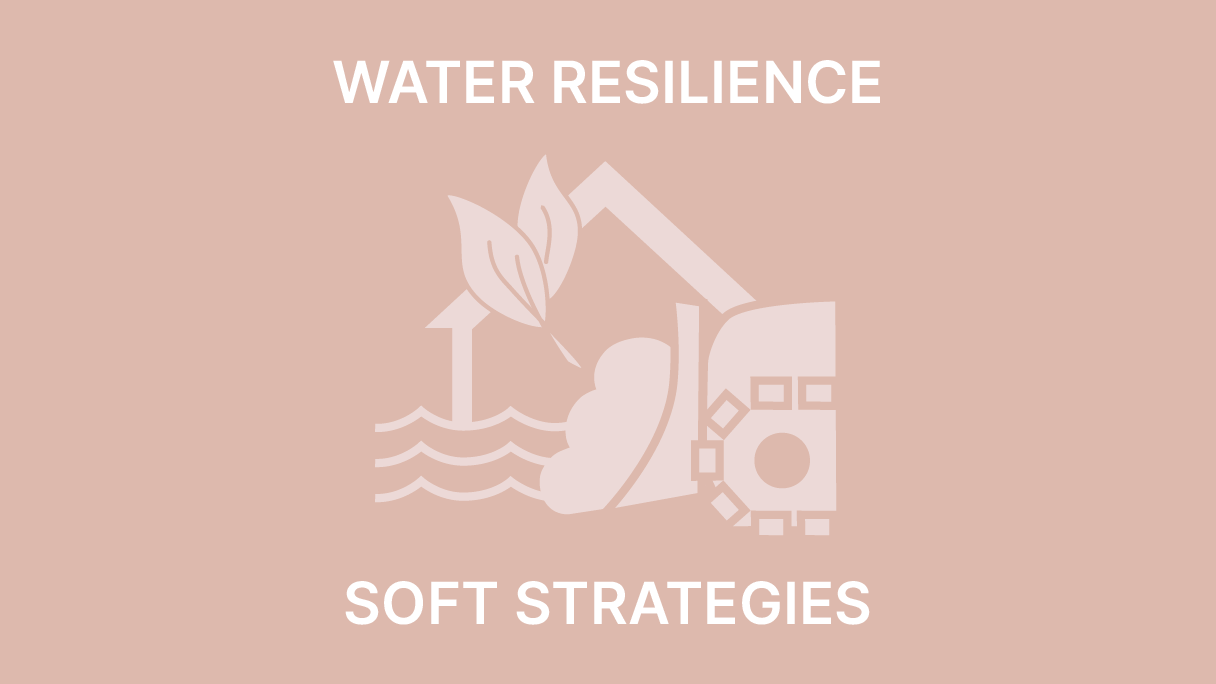Adaptable Infrastructure
Adaptability ensures that infrastructures keep meeting an individual’s, community’s and society’s changing needs over time, but also includes adapting to a changing climate. Adaptability ensures longevity: it reduces risk of premature building obsolesce and demolition when they no longer meet our needs (because they can be adapted) – this is part of circular thinking and climate change mitigation and adaptation approaches. Adaptability reduces transient communities and supports stability, diversity and community cohesion, this is also part of creating inclusive and equitable infrastructures and long-term resilience. As such your project should put adaptability at its core, at micro, meso and macro-scale. A key aspect of this is the creation of different scenarios and personas over time (e.g., scenarios of possible functions, changing climate, modes of use, etc.) and reflect this in at least one alternative layout (i.e. design) scenario for your project. Ensure that your project also enables future adaptability at different scales.
Green Infrastructure
Green infrastructure is the network of natural green spaces and landscapes within and around urban environments, such as food-growing areas, wetlands, forests, parks and wildlife gardens. Green infrastructure supports biodiversity, enhances ecosystem health, absorbs CO2 and manages adaptations to a changing climate (e.g. flood prevention and overheating). Co-benefits are supporting social activity and human well-being. Your project must tread lightly: after all, placing a new structure is hugely disruptive, as the developed land will have lost its existing ecological value forever. Your choice of site is therefore vital and value and protect existing natural habitats and leave the place better than it was before (i.e. retorative action). To do that, create a green infrastructure plan for your project that identifies and creates a map of the potential impact of your design on existing green infrastructure and on stakeholders and propose remedial measures to ensure a restorative approach. Distribute green spaces of different scales and diversity throughout the city within short walking distances and connect wildlife habitats through parks with green corridors and pedestrian spaces. Prioritise views of nature and trees, integrating generous physical access to different kinds and scales of nature for human and non-humans.
Blue Infrastructure
Description Blue infrastructures are natural and human-made water systems at different scales. Integrating blue infrastructure at different scales in your project has multiple benefits, for example for biodiversity, the urban micro climate, reduced water consumption, and they can act as social infrastructure and for climate adaptation. Working with water rather than against it can lead to restorative actions (e.g. by giving water space; recharging the ground water through permeable paving; enabling the thriving of other species).
In your project:
• Map natural and human-made water bodies and understand how your site is affected by water as a threat or an opportunity (e.g., rivers, sea) now and in the future.
• Use permeable landscape surfaces, include space for water retention systems that are also dual-purpose, i.e., spaces for leisure to act as social infrastructure and space for enhancing biodiversity (restorative actions) and that can store water in extreme weather events as part of climate change adaptation.
• To mitigate climate change at micro-scale, always consider efficient appliances as a priority. Then consider water recycling strategies that are low in energy use and embodied energy, e.g. simple rain water harvesting techniques.
Finally, sustainable urban drainage systems (SUDs) need to be combined at all scales: they all act together to mitigate and adapt to climate change and tackle the biodiversity crisis.
Planetary Health
Your project should never contribute to tipping points and ecological or climate breakdown. Instead, use your design to identify how you can positively impact the planet and restore some of the previous damage done. This means redirecting current human-centric design approaches towards an inclusive, biodiverse, restorative future using the principles of radical inclusivity, biophilia and topophilia. We should strive towards an approachable architecture that can be used by different living-beings in different (adaptable) ways. Following these principles steers us towards more ethical professional practices that support planetary health, instead of damaging it.
METI School
The school is an impressive example of a hand-crafted endeavour, highlighting excellent principles of sustainable design and architecture that resonates with the community. By skilfully integrating tradition wisdom, easily accessible renewable resources, and innovative building methods, the project preserves its traditional identity while also welcoming contemporary elements in its appearance and function. The school (for 168 students) adopts an alternative child-directed work method over conventional frontal lessons. Mirroring this philosophy, the two-story school architecture offers diverse spaces for children’s activities, aligning design with the educational approach.
Natural Materials
Natural materials are found in nature and can be used for structure elements, roofs, insulation, external and internal cladding or furniture. Renewable materials are those that can be easily replenished, such as timber, fax, cork, hemp, cob, stroke, grasses, salt, bamboo and seaweed. Non renewable materials should be natural and abundant, such as stone, earth, clay, sand or organic slightly processed materials. Biogenic materials sequester carbon and absorb more CO2 than they produce in extraction and manufacturing. Recently, there has been an approach to natural materials that focuses on innovation in cultivating, breeding, raising farming or growing future resources, such as wood foam, bio polymers, and fungal mycelium. These materials are cost effective, biodegradable, and have high insulation properties, flame resistance, and a favorable indoor climate
Self-sustaining Design Approaches
Self-sustaining design approaches at their core, these approaches embrace a holistic philosophy that seeks to harmonize human habitats with the natural world while reducing resource consumption and minimizing environmental impact.
Central to this concept is the aim to achieve self-sufficiency, wherein buildings generate their energy and resources, striving for net-zero or even positive energy balance. This involves integrating renewable energy sources such as solar panels, wind turbines, and geothermal systems, coupled with innovative energy storage solutions.
Passive design strategies play a vital role, leveraging the local climate and environment to optimize heating, cooling, and lighting without heavy reliance on mechanical systems. Water conservation is also paramount, employing techniques like rainwater harvesting, greywater recycling, and efficient irrigation.
Materials selection takes on a sustainable ethos, favouring eco-friendly and locally sourced options to reduce embodied energy and minimize transportation impact.
Regional Design Approaches
Regional design approaches embody the ethos of contextual sensitivity, blending cultural, climatic, and geographical influences to create structures harmoniously integrated with their surroundings. Rooted in the belief that architecture should respond to local conditions, these approaches celebrate regional materials, traditional craftsmanship, and vernacular styles. By embracing the unique characteristics of a specific locale, regional design fosters a sense of place and cultural identity. It seeks to optimize energy efficiency by harnessing natural resources and climate patterns. Moreover, regional design encourages sustainable practices by minimizing transportation of materials and reducing the carbon footprint associated with construction. Ultimately, it showcases a deep respect for the environment and heritage while offering innovative solutions that resonate with the community and enhance the built environment's overall resilience and longevity.
Designing for Climatic Zones
Designing for climates is the process of designing spaces that are well adapted to the local climate and weather conditions, with the goal of minimizing the building's energy consumption, maximizing indoor comfort, and reducing the negative impacts on the environment. Climate plays an important role in shaping human settlement, as it affects a ways people interact with the environment and the types of buildings and infrastructure that are required to support their needs. Contextual design and place-based design includes the spirit of place, also referred to as a genius loci, which focuses on the unique identity of place and its local natural systems, landscaping and environment. An example of this is the Danish vernacular wing houses and half timber houses, which were designed to withstand the harsh weather conditions in Denmark and were orientated with S facades or SW facades to maximize solar gain and minimize exposure to prevailing winds. Climate is affected by latitude, distribution of land and sea wind systems as well as the altitude of the location, and microclimates refer to the specific conditions and the immediate vicinity of a site such as wind patterns, temperature fluctuations and exposure to sunlight.
Climatic Zones
This talk is about the relationship between climate and architecture, and how understanding the climatic zones can help inform the design of a building. The northern and southern hemispheres, as well as the Equatorial zone, have unique environmental conditions that influence the design of spaces, the architectural approach, and the materials used. The global wind directions are largely influenced by the Earth's rotation and the unequal heating of the Earth's surface by the sun, and the distribution of land and water masses across the planet. Examples of wind directions include the trade winds, westerly winds, and polar easterlies. It is important to consider these climatic factors when designing a building, as the solar radiation and global winds can have a significant impact on the amount and intensity of solar radiation that a building receives.
Regenerative Design Approaches
Distinct from sustainable design, regenerative architecture reverses ecological damage and seeks a net-positive environmental impact. Transitioning from sustainability to regeneration, architects question how to not only use limited resources but also restore them. This approach fosters resilience to natural challenges, providing a progressive solution to the climate and biodiversity crisis.
The regenerative design process employs systemic thinking and involves integrating the natural world as both the inspiration and generator for architectural designs. It encompasses two essential aspects: minimizing environmental impacts through conscious material choices, reduced energy consumption, and intelligent design; and treating the environment as an equal partner in the architectural process. By understanding natural and living systems deeply, regenerative architecture embraces millions of years of evolution and engineering, creating structures that harmoniously coexist with their surroundings.
By embracing regenerative architecture, the construction industry can shift from minimizing harm to actively benefiting the environment, aligning design with nature's principles and promoting a more sustainable, prosperous future.
Resilient Design Approaches
Resilient design approaches entail the strategic integration of principles and strategies that enhance a building's capacity to withstand and recover from various stressors, such as natural disasters, climate change, and socio-economic shifts. This approach emphasizes not only the durability of structures, but also their adaptability and ability to bounce back in the face of adversity. Resilience operates across scales and timeframes, encompassing buildings, communities, and regions.
At the building scale, strategies encompass handling climate impacts, situating critical systems smartly, using future climatic models, passive survivability, robust materials, beauty, energy optimization, water conservation, waste solutions, local resourcing, and hazard-resistant specifications.
Community resilience involves social structures, local food systems, transport alternatives, stormwater management, communication hubs, education, and infrastructure planning.
Regionally, policies must value ecosystem services, protect aquifers, develop transportation and renewable energy networks, encourage diverse economies, and support regional manufacturing.
While total resilience might be unattainable, incremental steps can enhance resilience progressively, positioning systems and societies for better preparedness and responsiveness.
Water Resilience: Soft Strategies
Three key soft strategies for flood management include living shorelines, dunes and beach nourishment, and floating wetlands. Soft strategies emphasize enables effective flood management through holistic, nature-based solutions to mitigate flooding risks. They are gaining popularity due to their restorative nature, and are often paired with hard strategies for hybrid solutions. These strategies provide habitat for biodiversity and can serve as recreational spaces, although human disruption remains a concern.
Living shorelines are inclined natural banks with vegetation and natural materials that lessen wave impact, best suited for moderate flooding when combined with levees.
Dunes act as natural barriers, but proper vegetation is essential for stability. Armored dunes can enhance protection but need careful design.
Beach nourishment widens beaches, reducing erosion and storm surge impact, although its effectiveness varies. Designing these strategies involves protecting vegetation, creating paths, and setting back development.
Floating wetlands, made of buoyant materials, are adaptable and best for sheltered waters. They rise with floodwaters, filter pollutants, and provide wildlife habitat.
Challenges for soft strategies include extreme weather limitations, maintenance costs, and technical expertise. Opportunities lie in ecological benefits, affordability, community involvement, and environmental enhancement.
Health of Non-humans
Your project should never contribute to tipping points and ecological or climate breakdown. Instead, use your design to identify how you can positively impact the planet and restore some of the previous damage done. This means redirecting current human-centric design approaches towards an inclusive, biodiverse, restorative future using the principles of radical inclusivity, biophilia and topophilia. We should strive towards an approachable architecture that can be used by different living-beings in different (adaptable) ways. Following these principles steers us towards more ethical professional practices that support planetary health, instead of damaging it.
Future Generations
Designing for vague ‘future generations’ mainly focuses on the use of resources and the environmental impact of our actions and does not clarify who we design for today, in the present, nor who will be impacted in the future. In your project, you need to unfold why you design and who for. This includes: the local user, the public, the non-human and nature but also a global responsibility towards people, non-humans and nature further away, and ultimately our planet. We introduce the concept of ‘care’ which recognises and embraces our (inter)dependence, connection and responsibility towards others at its heart, including the non-human. This profoundly challenges the (modernist) ideal of an independent, visionary architect who only designs for themselves. But without this care, empathy and solidarity towards the user we cannot have truly sustainable architecture.
Low Energy Retrofit
Architects need to prevent building demolition and should transform the existing fabric instead of building new. Low energy retrofit not only reduces carbon emissions, resource use and urban sprawl, but also tackles social injustices (e.g. energy poverty) and energy security. Designing low energy retrofits is not just upgrading for energy efficiency, but also involves:
• Enhancing carbon storage by rewilding and using bio-based materials
• Circular economy principles and use of non-virgin materials
• Future proofing through future climate change adaptation
• Multifunctionality and adaptability, reducing excess floor area and sharing of spaces
• Avoid unintended consequences that affect health and well being or jeopardises the building fabric and that does not materialise energy and carbon reductions.
Daylight
One of the most important passive resilience approaches for your project is that of well daylit spaces and good views to outside appropriate to the building’s intended functions and user’s needs. Daylight and views / connection to outside are crucial for well-being, and reduce energy use. Good daylighting depends on plan depth and ceiling height, window locations and sizes and internal finishes and external reflections. Design should ‘lock in’ access to daylight at early stages: making changes is often not possible once built.














